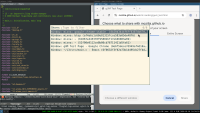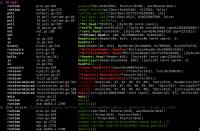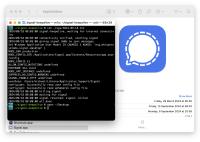Go to page:
2026 › January
-

Wayland is the successor to the X server (X11, Xorg) to implement the graphics stack on Linux. The Wayland project was actually started in 2008, a year before I created the i3 tiling window manager for X11 in 2009 — but for the last 18 years (!), Wayland was never usable on my computers. I don’t want to be stuck on deprecated software, so I try to start using Wayland each year, and this articles outlines what keeps me from migrating to Wayland in 2026. Read more →
2025 › November
-

For every cloud service I use, I want to have a local copy of my data for backup purposes and independence. Unfortunately, the gphotos-sync tool stopped working in March 2025 when Google restricted the OAuth scopes, so I needed an alternative for my existing Google Photos setup. In this post, I describe how I have set up Immich, a self-hostable photo manager. Read more →
2025 › October
-

I have been using a MacBook Pro M4 as my portable computer for the last half a year and wanted to share a few short impressions. As always, I am not a professional laptop reviewer, so in this article you won’t find benchmarks, just subjective thoughts! Read more →
2025 › September
-

I liked the NixOS meetup earlier this year, and at the end of the meetup they told everyone about NixCon 2025, which would be happening in Switzerland this year, at the very same location, the University Of Applied Sciences OST in Rapperswil, so I decided to go! In this trip report, I want to give you a rough impression of how I experienced this awesome conference :) Read more →
-

The Intel 285K CPU in my high-end 2025 Linux PC died again! 😡 Notably, this was the replacement CPU for the original 285K that died in March, and after reading through the reviews of Intel CPUs on my electronics store of choice, many of which (!) mention CPU replacements, I am getting the impression that Intel’s current CPUs just are not stable 😞. Therefore, I am giving up on Intel for the coming years and have bought an AMD Ryzen 9950X3D CPU instead. Read more →
2025 › August
-

Passwords and secrets like cryptographic key files are everywhere in computing. When configuring a Linux system, sooner or later you will need to put a password somewhere — for example, when I migrated my existing Linux Network Storage (NAS) setup to NixOS, I needed to specify the desired Samba passwords in my NixOS config (or manage them manually, outside of NixOS). For personal computers, this is fine, but if the goal is to share system configurations (for example in a Git repository), we need a different solution: Secret Management. Read more →
2025 › July
-

I wanted to use GoCV for one of my projects (to find and extract paper documents from within a larger scan), without permanently having OpenCV on my system. This seemed like a good example use-case to demonstrate a couple of Nix commands I like to use, covering quick interactive one-off dev shells to fully declarative, hermetic, reproducible, shareable dev shells. Read more →
-

In this article, I want to show how to migrate an existing Linux server to NixOS — in my case the CoreOS/Flatcar Linux installation on my Network Attached Storage (NAS) PC. I will show in detail how the previous CoreOS setup looked like (lots of systemd units starting Docker containers), how I migrated it into an intermediate state (using Docker on NixOS) just to get things going, and finally how I migrated all units from Docker to native NixOS modules step-by-step. Read more →
2025 › June
-

For one of my network storage PC builds, I was looking for an alternative to Flatcar Container Linux and tried out NixOS again (after an almost 10 year break). There are many ways to install NixOS, and in this article I will outline how I like to install NixOS on physical hardware or virtual machines: over the network and fully declaratively. Read more →
2025 › May
-

Update (2025-09-07): The replacement CPU also died and I have given up on Intel. See Bye Intel, hi AMD! for more details on the AMD 9950X3D. Turns out my previous attempt at this build had a faulty CPU! With the CPU replaced, the machine now is stable and fast! 🚀 In this article, I’ll go into a lot more detail about the component selection, but in a nutshell, I picked an Intel 285K CPU for low idle power, chose a 4TB SSD so I don’t have to worry about running out of storage quickly, and a capable nvidia graphics card to drive my Dell UP3218K 8K monitor. Read more →
-
I have recently started using the grobi program by Alexander Neumann again and was delighted to discover that it makes using my fiddly (but wonderful) Dell 32-inch 8K monitor (UP3218K) monitor much more convenient — I get a signal more quickly than with my previous, sleep-based approach. Read more →
2025 › March
-

Update (2025-05-15): Turns out the CPU was faulty! See My 2025 high-end Linux PC for a new article on this build, now with a working CPU. Update (2025-09-07): The replacement CPU also died and I have given up on Intel. See Bye Intel, hi AMD! for more details on the AMD 9950X3D. In January I ordered the components for a new PC and expected that I would publish a successor to my 2022 high-end Linux PC 🐧 article. Instead, I am now sitting on a PC which regularly encounters crashes of the worst-to-debug kind, so I am publishing this article as a warning for others in case you wanted to buy the same hardware. Read more →
2025 › February
-

I was helping someone get my gokrazy/rsync implementation set up to synchronize RPKI data (used for securing BGP routing infrastructure), when we discovered that with the right invocation, my rsync receiver would just hang indefinitely. This was a quick problem to solve, but in the process, I realized that I should probably write down a few Go debugging tips I have come to appreciate over the years! Read more →
2024 › December
-
I originally published this post in the Go blog, but am publishing this copy of it in my own blog as well for readers who don’t follow the Go blog. [Protocol Buffers (Protobuf) is Google’s language-neutral data interchange format. See protobuf.dev.] Read more →
-

A year ago, I got a solar panel for my balcony — an easy way to vote with your wallet to convert more of the world’s energy usage to solar power. That was a great decision and I would recommend everyone get a solar panel (or two)! Read more →
2024 › November
-

Let’s say you created a Go program that stores data in PostgreSQL — you installed PostgreSQL, wrote the Go code, and everything works; great! But after writing a test for your code, you wonder: how do you best provide PostgreSQL to your automated tests? Do you start a separate PostgreSQL in a Docker container, for example, or do you maybe reuse your development PostgreSQL instance? Read more →
2024 › October
-

Not all bugs can easily be reproduced — sometimes, all you have is a core dump from a crashing program, but no idea about the triggering conditions of the bug yet. When using Go, we can use the delve debugger for core dump debugging, but I had trouble figuring out how to save byte slice contents (for example: the incoming request causing the crash) from memory into a file for further analysis, so this article walks you through how to do it. Read more →
2024 › September
-

I have a couple of people who are best reachable on the Signal messaging app, but not that many. This exposes me to an awkward edge case of Signal’s design decisions: Whenever I get a message (on my phone), I want to reply to it (on my laptop) only to discover that Signal has un-linked my laptop because of inactivity and won’t sync the message history from my phone to my laptop, making it impossible to quote-reply to messages. Read more →
2024 › July
-

When I saw the first reviews of the ASRock DeskMini X600 barebone, I was immediately interested in building a home-lab hypervisor (VM host) with it. Apparently, the DeskMini X600 uses less than 10W of power but supports latest-generation AMD CPUs like the Ryzen 7 8700G! Read more →
2024 › February
-

I maintain two builds of the Linux kernel, a linux/arm64 build for gokrazy, my Go appliance platform, which started out on the Raspberry Pi, and then a linux/amd64 one for router7, which runs on PCs. The update process for both of these builds is entirely automated, meaning new Linux kernel releases are automatically tested and merged, but recently the continuous integration testing failed to automatically merge Linux 6․7 — this article is about tracking down the root cause of that failure. Read more →
2024 › January
-

When a service fails to start up enough times in a row, systemd gives up on it. On servers, this isn’t what I want — in general it’s helpful for automated recovery if daemons are restarted indefinitely. As long as you don’t have circular dependencies between services, all your services will eventually come up after transient failures, without having to specify dependencies. Read more →
2023 › October
-

For over 10 years now, I run two self-built NAS (Network Storage) devices which serve media (currently via Jellyfin) and run daily backups of all my PCs and servers. In this article, I describe my goals, which hardware I picked for my new build (and why) and how I set it up. Read more →
2023 › July
-

For the last 10 years, I have been interested in hi-DPI monitors, and recently I read about an interesting new monitor: Dell’s 32-inch 6K monitor (U3224KBA), a productivity monitor that offers plenty of modern connectivity options like DisplayPort 2, HDMI 2 and Thunderbolt 4. Read more →
2023 › January
-

gokrazy is an appliance platform for Go programs: with just a few commands, you can deploy your Go program(s) on a Raspberry Pi or a (typically small) PC. I’m excited to let you know that gokrazy now comes with a re-designed gok command line tool and gokrazy instance configuration mechanism! Read more →
2022 › October
-

I was pleasantly surprised by how easy it was to make it possible to push a PC’s power button remotely via MQTT by wiring up an ESP32 microcontroller, a MOSFET, a resistor, and a few jumper wires. While a commercial solution like IPMI offers many more features like remote serial, or remote image mounting, this DIY solution feels really magical, and has great price performance if all you need is power management. Read more →
2022 › August
-

For the guest WiFi at an event that eventually fell through, we wanted to tunnel all the traffic through my internet connection via my home router. Because the event is located in another country, many hours of travel away, there are a couple of scenarios where remote control of my home router can be a life-saver. For example, should my home router crash, remotely turning power off and on again gets the event back online. Read more →
2022 › July
-

This post is the third article in a series of blog posts about rsync, see the Series Overview. With rsync up and running, it’s time to take a peek under the hood of rsync to better understand how it works. How does rsync work? When talking about the rsync protocol, we need to distinguish between: Read more →
-

This post is the second article in a series of blog posts about rsync, see the Series Overview. Now that we know what to use rsync for, how can we best integrate rsync into monitoring and alerting, and on which operating systems does it work? Read more →
2022 › June
-

This post is the first article in a series of blog posts about rsync, see the Series Overview. To motivate why it makes sense to look at rsync, I present three scenarios for which I have come to appreciate rsync: DokuWiki transfers, Software deployment and Backups. Read more →
-

For many years, I was only a casual user of rsync and used it mostly for one-off file transfers. Over time, I found rsync useful in more and more cases, and would recommend every computer user put this great tool into their toolbox 🛠 🧰 ! Read more →
Did you like this post? Subscribe to this blog’s RSS feed to not miss any new posts!
I run a blog since 2005, spreading knowledge and experience for over 20 years! :)
If you want to support my work, you can buy me a coffee.
Thank you for your support! ❤️